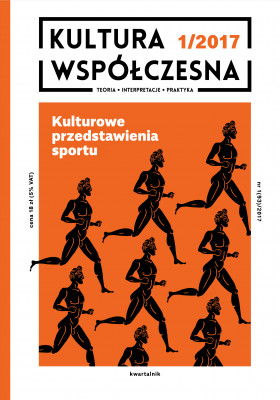Settings and search
Cultural images of sport


Table of contents
I CULTURAL IMAGES OF SPORT
Iwona Kurz, Piotr Kubkowski
Introduction. Cultural sport shows. Sport. And what about it? What can be seen at a sport show?
Dariusz Kosiński
Performativity and dramatology of sport. An attempt at a theoretical somersault
Piotr Kubkowski
Sports broadcasts. Findings
Antoni Michnik
Game, set, algorithm. Intermedia projects applying tennis data
Patrycja Wróbel
Performativity of swimming
Jakub Papuczys
Here is NBA. About the reception of American basketball in Poland
Konrad Niciński
Transformation in soccer between 1989 and 1993. Sunday of miracles as a case study
Kornelia Sobczak
Fabulous ’90s of the Polish soccer
Igor Piotrowski
Changes in Warsaw sports’ infrastructure and topography in the light of textual and photographic sources
Adam Kadenaci
Transformation of sport spaces in Warsaw
II SPORT WITHOUT RETOUCHING
Magdalena Juźwik
Fight with grace. Body aesthetics in wrestling
Jagoda Schmidt
Feminine climbing. Analysis of gender in the climbing community of Warsaw
Przemysław Nosal
Three lives of Oscar Pistorius
Grzegorz Kubiński
A celebrity or a misfit. The figure of the paralympic athlete in sports narrative
Konrad Borek
In a virtual stadium – soccer as the space of imagination
III REVIEWS AND OVERVIEWS
Kalina Kukiełko-Rogozińska
The Gutenberg Galaxy of Marshall McLuhan
Kamil Lipiński
In-between. Cultures of communication. Overview of a conference organized by NECS, Potsdam, 26-31.06.2016
IV DISCUSSION REGARDING THE ENCYCLOPEDIA OF CULTURE STUDIES
Anna Czajczyk, Ryszard Zajączkowski
Article opening the discussion: A few remarks concerning the need for Encyclopedia of Culture Studies
Discussion: Anna Zejdler-Janiszewska, Eugeniusz Wilk, Anna Czajka-Cunico, Krzysztof Moraczewski, ks. Witold Kawecki, Ewa Kosowska, Stefan Bednarek, Grzegorz Godlewski
Anna Czajczyk, Ryszard Zajączkowki
Article closing the discussion: Encyclopedia of Culture Studies – additional remarks
Cultural images of sport
While outlining the theory of sport studies, the author suggests that sport (understood as a sum of activities, institutions and phenomena connected with mediatized professional practices) should not be seen any more as marginal, but indeed the most complete representation of the world culture: a meta-commentary of the present times and their fullest expression. Performance studies regarding sport that are proposed in the text would be inspired by the theory of J. McKenzie. The object of research could be analysed as performance, show and spectacle. The text explains and further develops interpretative perspectives of the last one.
The text aims at indicating the importance of the acoustic band in television transmission, called here audio sports performance (słuchowisko sportowe).The author provides interpretation of a few different ways of sound production that offer television viewers the experience of participation in a cultural performance. Technical issues are analysed according to the methodology of sound studies, performance studies and anthropological theory of cultural media.
The author describes transformations in current intermedia projects and in sport. The analysis concentrates on Robert Rauschenberg’s Open Score (1966) performance and on the project US Open Sessions United Tennis Association, IBM, Tools of North America and James Murphy (2014). These examples are used to indicate a symbolic transition from counter cultures to a programming culture as well as current changes in tennis in times of computerisation, corporationalisation and development of data analysis in sport.
The author analyses first images of the American NBA league in Poland at the beginning of the 1990’s pointing out to the redundant way in which they represented the basketball match. Those first broadcasts were limited to an attractive assembly of the most impressive and spectacular moves - each meeting was screened only for the most interesting and the most showy actions. The author tackles also the issue regarding technological aspect of broadcasting: assembly of materials sent on VHS commented subsequently in a studio as if the match was played live. The author places that specific shift within a broader context of Polish cultural practices that occurred at the time of the transformation upheaval. He also comments on the way the ambivalent “Negro” figure was perceived both in NBA broadcasts and in other cultural texts of that time.
Transformation in soccer between 1989 and 1993. Sunday of miracles as a case study - Konrad Niciński
The article focuses on transitions in Polish soccer in the transformation period between 1989 and 1993. They are looked at from the perspective of performance studies and cultural history of sport. The main part of the text is devoted to a case study focusing on “the Sunday of miracles” referring to events of the final series of the 1992/93 soccer season. The article discusses also the issues concerning media narration and relations between sport and political transformations.
Observation of sport shows, understood both as performances and practices connected with them, provides interesting and important evidence for the analysis of the Polish process of „transformation”, as well as the spirit of the 1990s, its aspirations and projects of modernity, as well as “normality” (modernity and „normality” are often treated synonymously). The film chosen for analysis, however, shows not the images designed and made to be imitated, but rather the spaces of transience, long endurance of the older (infra)structure and the mediation between different models of participation in cultural practices. What seems especially interesting is what emerges without the conscious engagement of the viewer, accidentally and unintentionally, and what becomes meaningful and can be reflected upon only in hindsight.
In spite of the construction of a few important venues, inter-war sport did not have appropriate representation in the space of the city wrestling with the heritage of partitions and industrial capitalism. Sport facilities appeared often in accidental places, hidden in the mazy structure of the capital. Despite a radical change in property and space relations, post-war Warsaw could not keep up with building and maintenance of sports infrastructure. The period after 1989 featured further delays resulting from deep political transformation. However, the last ten years have marked a serious revitalisation of old venues and building of new ones (old spaces facilitating sports and recreation are fragmented and a new network of venues is built).
Warsaw has been witnessing a process of shrinking of public sports spaces that hinders activities of amateur athletes. However, that phenomenon is accompanied by an increased use of public spaces for physical activities. People practising urban sports work-out in parks, urban squares and streets. The world of sport is changing and it should be followed by changes in infrastructure. City dwellers are quicker in reacting to that transformation and bottom-up they try to adapt space to their needs. Local councils should notice that potential and begin supporting them.
Sport without retouching
The article is devoted to wrestling – one of the oldest disciplines of sport. My analysis concentrates on the sports show in aesthetics and theatre categories. Is it possible to wrestle with grace, beautifully? What is the athlete’s body like? Can sport be considered art? Starting with a historical overview of wrestling as a sports discipline, I move on to the category of corporeality and theatralisation in sport competition. I observe the way wrestling looked like in the past and what it looks like today. I describe what is important for the athlete and how he disciplines his body.
Sport climbing is usually perceived as a male activity. That perception is mirrored by the language of climbing, climbers’ behaviour and media discourse. In spite of that, climbing women feel comfortable in the climbing community and more and more often stress their presence. The article describes how the women from Warsaw who practice climbing perceive themselves and their femininity, how much of “male” behaviour they adopt in the climbing community, how climbing influences their everyday life, appearance, attire. It also discusses known among climbers category of “feminine climbing” and its multiple meanings.
Oscar Pistorius, an amputee runner from the Republic of South Africa moving on prosthetic legs became a person whose presence on sports arenas put under question the foundations of our knowledge about social life. The text focuses on the analysis of the runner’s social phenomenon. It is carried out through the perspective of his “three lives” and the event that concludes them. The first life of Pisorius is a life of a disabled person. It poses questions about the limits of possibilities of the human body and its improvements. The second life of the South African athlete concerns his connections with technology. The fact that he is using ultra-modern prosthetics has turned him into a “cyborg” and “blade runner”. The third life regards a social transgression that the athlete embodies. The event that ends the sports life of Pistorius concerns multi-dimentional postcolonial violence.
The example of the Olympics in Rio showed how much the declared acceptance of disability differs from the reality. In spite of the fact that Paralympic athletes often win more medals and awards at sports events, their presence in media and social discourse is unnoticeable. On the other hand, in the convention described as “inspiration porn”, impaired athletes are exposed and treated by media as models for overcoming various life difficulties, they are held up as examples not only for the disabled. Such a discrepancy of attitudes is best seen in sport that in view of its egalitarian principles should lead to levelling of differences. An obvious question arises regarding the mechanism responsible for such an ambivalent approach to disability. It cannot be explained by the lack of social and cultural interest in a given discipline, for the disabled people practice often the same sports as the healthy ones. An attempt at finding an answer to the question regarding the mechanism of erasing the disabled body from the space of the sports show shall be the main goal of the proposed article. Does the common understanding of sport as a tool consolidating social or national identity change when disabled people participate in sports competition? Hasn’t sport, in spite of its egalitarian ideals, become a tool to exclude otherness? And haven’t sport competitions become an attempt at extorting compliance with determined values? Don’t they serve to reinforce the socially demanded model of the individual? Should the answers be positive, we are faced again with the question regarding the relevance of practising and promoting sport of the disabled - is the character and identity of individuals truly shaped by the sports dispositif, or does it only serve to include sports competitions within the framework of political correctness? The relationship between sport and disability seems to be something more than only marginal attention given to Paralympics in media. It comprises issues of ethics of values, of domination and marginalisation, while embracing shaping processes of inter-group relations. Finally, it redefines the individual and his or her significance and legitimacy in the society.
The article is an attempt, based on ethnographic field research carried out by the author, at an anthropological analysis of the Internet soccer manager Hattrick. It focuses on the description of the online game as an institution understood verbally, created as a result of symbolic practices of its members. The author aims at showing the way in which soccer may function as social context where contacts between individual participants of the virtual world are formed and maintained. He also asks about the relationship of that universe with the world outside of the computer screen.
Reviews and overviews
The Gutenberg Galaxy of Marshall McLuhan
- Kalina Kukiełko-Rogozińska
In-between. Cultures of communication. Overview of a conference organized by NECS, Potsdam, 26-31.06.2016
- Kamil Lipiński
Discussion regarding the encyclopedia of culture studies
Anna Czajczyk, Ryszard Zajączkowski, A few remarks concerning the need for Encyclopedia of Culture Studies
Anna Zejdler-Janiszewska, Eugeniusz Wilk, Anna Czajka-Cunico, Krzysztof Moraczewski, ks. Witold Kawecki, Ewa Kosowska, Stefan Bednarek, Grzegorz Godlewski
Anna Czajczyk, Ryszard Zajączkowki, Encyclopedia of Culture Studies – additional remarks
